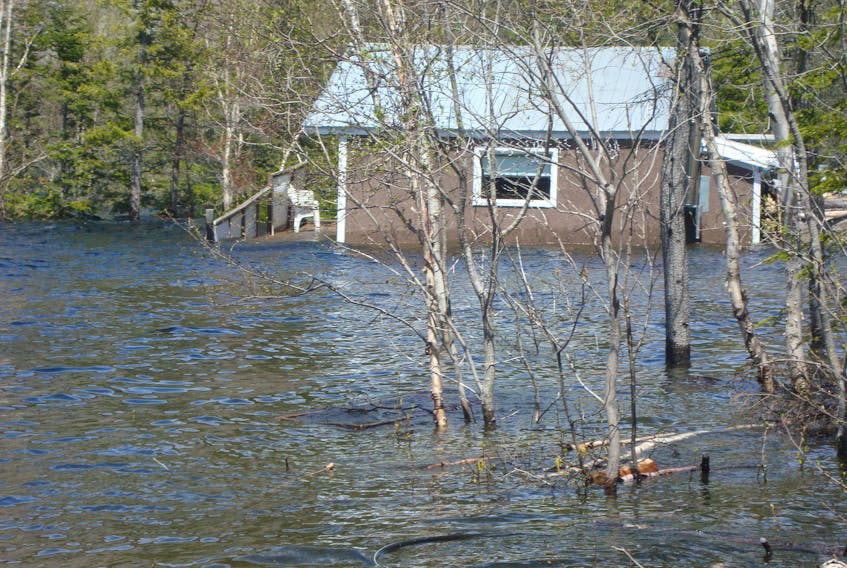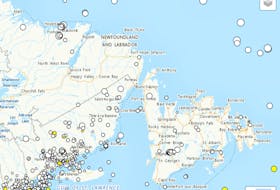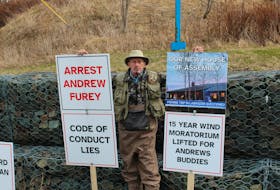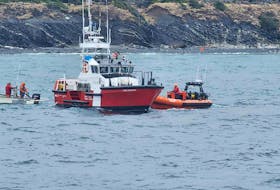The waters of Bottomless Pond have reportedly receded a little bit, but the mystery of why conditions there remain so troublesome continues.
RELATED:
'Side-scan sonar to be used to investigate worsening Bottomless Pond flooding'
'Bottomless Pond cabin owner frustrated with waiting for flood water levels to recede'
'Flooded cabin owner says he’s never seen Bottomless Pond rise so high'
The remote pond located south of Bonne Bay Big Pond has several cabins that have been flooded by unusually high levels of water from this past spring’s snowmelt and significant rainfall.
Bottomless Pond is suspected to have natural drainage below its surface, though how this works is not clearly understood. It is surmised that this drainage may have become blocked with debris brought into the lake by runoff.
Recently, at the request of cabin owners and the constituency office of Premier Dwight Ball — who represents the Humber-Gros Morne district in which Bottomless Pond is located — side-scan sonar equipment was brought in to see if the cause of the problem could be identified.
Ball’s bother and Deer Lake Mayor Dean Ball, is a volunteer member of the Deer Lake Underwater Recovery Team that owns the side-scan sonar gear.
He told The Western Star that several subsurface drainage holes were examined by the sonar equipment, but no blockages were evident.
It’s not known exactly where those holes lead to, but Dean Ball said it’s not likely the blockages are deep in those holes and unable to be seen by the sonar.
“You would think there would still be debris around these openings as a result of water being drawn into them, but there’s not,” Ball said.
The sonar took images of other areas that are not normally underwater, including a bridge and a school bus that Ball said are still under approximately 23 feet of water.
Mark Hoyles owns one of the cabins deemed inaccessible because of the extremely high water levels.
He would like to find out if it is a subsurface blockage elsewhere or some other hydrological reason as to why he’s at risk of losing his cabin investment.
When Hoyles was in as near to his cabin as he could get last week, the markers he had set along the shore indicated the water had dropped about four inches. When he visited again Thursday, the water had fallen close to another 1 ½ inches.
Hoyles is unsure if the water is finally seeping through the pond’s drainage system or if the warmer temperatures has evaporated some of it.
“I hope it is starting to seep and something somewhere gives so it can drain off faster,” he said. “If it only keeps going down this slow, it will be late September before it gets below the floor of my cabin.”
During his latest visit, Hoyles took careful note of the water level and said he will be checking it again after the rain expected Friday evening to see what impact the latest precipitation has had.
Hoyles is worried the cabin will still be flooded by the time winter comes and the pond begins to freeze over again.
He has previously stated that he doesn’t think it’s right for cabin owners who have not been able to access their cabins because of this situation to have to pay their lease fees to the provincial government.
The Western Star looked into that and, according to the Crown Lands division of the Department of Fisheries and Land Resources, there is no program available that would allow for reduced or waived fees.
The provincial Department of Municipal Affairs and Environment had initially investigated the flooding problem, but has not been conducting any regular monitoring since. It could not confirm Hoyles’ observations that the water levels have been dropping in the last week.
The department’s water resources management determined that continuous monitoring was not required and that water levels were anticipated to recede with time.









